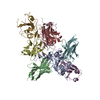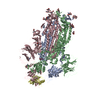+Search query
-Structure paper
| Title | A broad neutralizing nanobody against SARS-CoV-2 engineered from an approved drug. |
|---|---|
| Journal, issue, pages | Cell Death Dis, Vol. 15, Issue 6, Page 458, Year 2024 |
| Publish date | Jun 28, 2024 |
 Authors Authors | Qianyun Liu / Yuchi Lu / Chenguang Cai / Yanyan Huang / Li Zhou / Yanbin Guan / Shiying Fu / Youyou Lin / Huan Yan / Zhen Zhang / Xiang Li / Xiuna Yang / Haitao Yang / Hangtian Guo / Ke Lan / Yu Chen / Shin-Chen Hou / Yi Xiong /  |
| PubMed Abstract | SARS-CoV-2 infection is initiated by Spike glycoprotein binding to the human angiotensin-converting enzyme 2 (ACE2) receptor via its receptor binding domain. Blocking this interaction has been proven ...SARS-CoV-2 infection is initiated by Spike glycoprotein binding to the human angiotensin-converting enzyme 2 (ACE2) receptor via its receptor binding domain. Blocking this interaction has been proven to be an effective approach to inhibit virus infection. Here we report the discovery of a neutralizing nanobody named VHH60, which was directly produced from an engineering nanobody library based on a commercialized nanobody within a very short period. VHH60 competes with human ACE2 to bind the receptor binding domain of the Spike protein at S, Sand S as determined by structural analysis, with an affinity of 2.56 nM. It inhibits infections of both ancestral SARS-CoV-2 strain and pseudotyped viruses harboring SARS-CoV-2 wildtype, key mutations or variants at the nanomolar level. Furthermore, VHH60 suppressed SARS-CoV-2 infection and propagation 50-fold better and protected mice from death for twice as long as the control group after SARS-CoV-2 nasal infections in vivo. Therefore, VHH60 is not only a powerful nanobody with a promising profile for disease control but also provides evidence for a highly effective and rapid approach to generating therapeutic nanobodies. |
 External links External links |  Cell Death Dis / Cell Death Dis /  PubMed:38937437 / PubMed:38937437 /  PubMed Central PubMed Central |
| Methods | EM (single particle) / X-ray diffraction |
| Resolution | 3.2 - 3.4 Å |
| Structure data | EMDB-38418, PDB-8xki:  PDB-8xk2: |
| Chemicals |  ChemComp-NAG: |
| Source |
|
 Keywords Keywords | ANTIVIRAL PROTEIN/IMMUNE SYSTEM / COVID-19 / spike glycoprotein / virus / antibody / VIRAL PROTEIN/IMMUNE SYSTEM / VIRAL PROTEIN-IMMUNE SYSTEM complex / ANTIVIRAL PROTEIN / ANTIVIRAL PROTEIN-IMMUNE SYSTEM complex |
 Movie
Movie Controller
Controller Structure viewers
Structure viewers About Yorodumi Papers
About Yorodumi Papers






